Mary and Martha may refer to:
Mary may refer to:
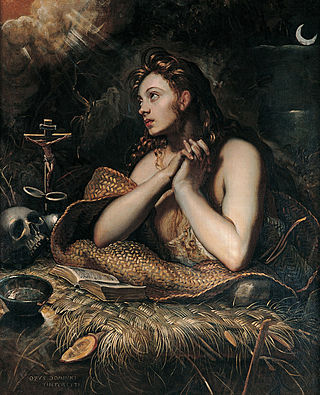
Mary Magdalene was a woman who, according to the four canonical gospels, traveled with Jesus as one of his followers and was a witness to His crucifixion and resurrection. She is mentioned by name twelve times in the canonical gospels, more than most of the apostles and more than any other woman in the gospels, other than Jesus's family. Mary's epithet Magdalene may be a toponymic surname, meaning that she came from the town of Magdala, a fishing town on the western shore of the Sea of Galilee in Roman Judea.

Mary of Bethany is a biblical figure mentioned by name in the Gospel of John and probably the Gospel of Luke in the Christian New Testament. Together with her siblings Lazarus and Martha, she is described as living in the village of Bethany, a small village in Judaea to the south of the Mount of Olives near Jerusalem.

Martha is a biblical figure described in the Gospels of Luke and John. Together with her siblings Lazarus and Mary of Bethany, she is described as living in the village of Bethany near Jerusalem. She was witness to Jesus resurrecting her brother, Lazarus.
Bethany College may refer to:
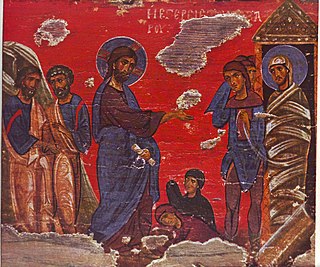
Lazarus of Bethany is a figure within the Christian Bible, mentioned in the New Testament in the Gospel of John, whose life is restored by Jesus four days after his death. This is seen by Christians as one of the miracles of Jesus. In the Eastern Orthodox Church, Lazarus is venerated as Righteous Lazarus, the Four-Days Dead. The Eastern Orthodox and Catholic traditions offer varying accounts of the later events of his life.
Saint Martha may refer to:
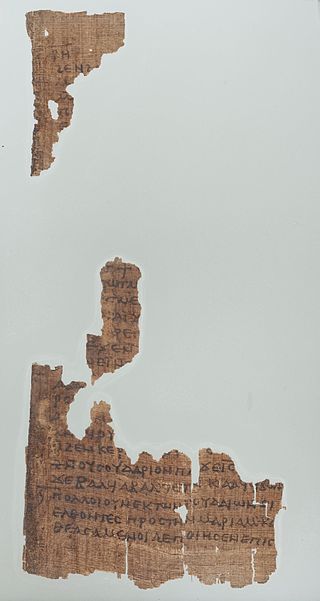
John 11 is the eleventh chapter of the Gospel of John in the New Testament of the Christian Bible. It records the raising of Lazarus from the dead, a miracle of Jesus Christ, and the subsequent development of the chief priests' and Pharisees' plot against Jesus. The author of the book containing this chapter is anonymous, but early Christian tradition uniformly affirmed that John composed this Gospel.

John 12 is the twelfth chapter of the Gospel of John in the New Testament of the Christian Bible. It narrates an anointing of Jesus' feet, attributed to Mary of Bethany, as well as an account of the triumphal entry of Jesus Christ into Jerusalem. The author of the book containing this chapter is anonymous, but early Christian tradition uniformly affirmed that John composed this Gospel.

The anointings of Jesus’s head or feet are events recorded in the four gospels. The account in Matthew 26, Mark 14, takes place on Holy Wednesday, while the account in John 12 takes place 6 days before Passover in Bethany, a village in Judaea on the southeastern slope of the Mount of Olives, where Lazarus lived. In Matthew and Mark, he is anointed by an unnamed woman. In John, the woman is identified as Mary of Bethany, the sister of Martha and Lazarus of Bethany. The event in Luke features an unnamed sinful woman, and is in the northern region, as Luke 7 indicates Jesus was ministering in the northern regions of Nain and Capernaum. The honorific anointing with perfume is an action frequently mentioned in other literature from the time; however, using long hair to dry Jesus's feet, as in John and Luke, is not recorded elsewhere, and should be regarded as an exceptional gesture. Considerable debate has discussed the identity of the woman, the location, timing, and the message.
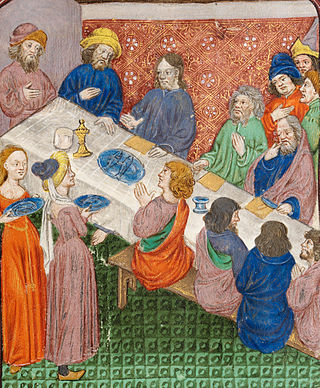
Simon the Leper is a biblical figure who lived in Bethany, a village in Judaea on the southeastern slope of the Mount of Olives. He is mentioned in the Gospels according to Matthew and Mark. These books tell of how Jesus made a visit to the house of Simon the Leper at Bethany during the course of which a woman anoints the head of Jesus with costly ointment. Bethany was also the home of Mary, Martha, and Lazarus.
Saint Mary is a term for Mary, mother of Jesus.
Lazarus Saturday in Eastern Christianity refers to the moveable feast before Palm Sunday to which it is liturgically linked. It celebrates the raising of Lazarus of Bethany. Bethany is recorded in the New Testament as a small village in Judaea, the home of the siblings Mary of Bethany, Martha, and Lazarus, as well as that of Simon the Leper.

Bethany, locally called in Arabic Al-Eizariya or al-Aizariya, is a Palestinian town in the Jerusalem Governorate of Palestine, bordering East Jerusalem, in the West Bank. The name al-Eizariya refers to the New Testament figure Lazarus of Bethany, who according to the Gospel of John, was raised from the dead by Jesus in the town. The traditional site of the miracle, the Tomb of Lazarus, in the city is a place of pilgrimage.
Bethany (Greek: Βηθανία, which is probably of Aramaic or Hebrew origin, meaning “House of Affliction" is a feminine given name derived from the Biblical place name, Bethany, a town near Jerusalem, at the foot of the Mount of Olives, where Lazarus lived in the New Testament, along with his sisters, Mary and Martha, and where Jesus stayed during Holy Week before his crucifixion.

Christ in the House of Martha and Mary is a painting finished in 1655 by the Dutch Golden Age painter Johannes Vermeer. It is now in the Scottish National Gallery in Edinburgh. It is the largest painting by Vermeer and one of the very few with an overt religious motive. The story of Christ visiting the household of the two sisters Mary of Bethany and Martha goes back to the New Testament. The work has also been called Christ in the House of Mary and Martha.

Jesus's interactions with women are an important element in the theological debate about Christianity and women. Women are prominent in the story of Jesus. According to the resurrection story, the resurrected Jesus was first seen by women.

Jesus at the home of Martha and Mary refers to a Biblical episode in the life of Jesus in the New Testament which appears only in Luke's Gospel, immediately after the Parable of the Good Samaritan. Luke's account reads:

The name Mary, appears 54 times in the New Testament, in 49 verses. It was the single most popular female name among Jews of the Roman province of Judaea at the time, borne by about one in four women, and most of the New Testament references to Mary provide only the barest identifying information. Scholars and traditions therefore differ as to how many distinct women these references represent and which of them refer to the same person.
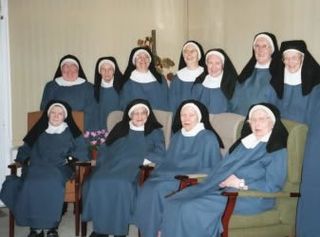
The Society of the Sisters of Bethany (SSB) is an Anglican religious order. The sisters follow the Rule of St Augustine. The mother house is now the House of Bethany in Southsea.